The cost of solar systems has reduced by almost 70 percent over the course of ten years. To further incentivize solar installation, many solar rebates and credits are available statewide. Rooftop solar panels and battery storage investments seem like a big deal for some people. However, there are various solar tax credits available for homeowners. These incentives will eventually help offset the initial cost of your solar system. These credits may include Federal Investment Tax Credits, State Tax Credits, Net metering, Property Tax Exemptions, Sales Tax Exemptions, Solar Renewable Energy Certificates, and Low-interest loans. In this article, we will delve into all of these solar tax credits one by one.

What are Solar Tax Credits?
Solar tax credits can reduce your taxable income and can directly impact your annual tax bill. A tax credit can decrease the amount of tax you owe or increase your tax refund. These credits differ from tax deductions and exemptions.
Types of Solar Tax Credits:
Federal Solar Investment Tax Credit:
The Investment Tax Credit (ITC) is a tax credit that is applicable within the premise of the United States, which is to incentivize the solar energy. The tax credit is the reduction in the individual’s or a business’s taxable income based on the cost of solar equipment, including labor, materials, and installation expenses. The Solar ITC offers a tax credit equal to a percentage of the cost of installing a solar system. The credit is applied against the taxpayer’s federal income tax liability. However, ITC is a non-refundable tax credit.
The ITC was initially established in 2006 and has been extended several times. Residential solar system projects built in 2020 or 2021 were eligible for a 26% tax credit. However, projects built from 2022 to 2032 are eligible for a 30% tax credit. The residential solar tax credit will be reduced to 26% in 2033 and 22% in 2034 before expiring at the beginning of 2035.
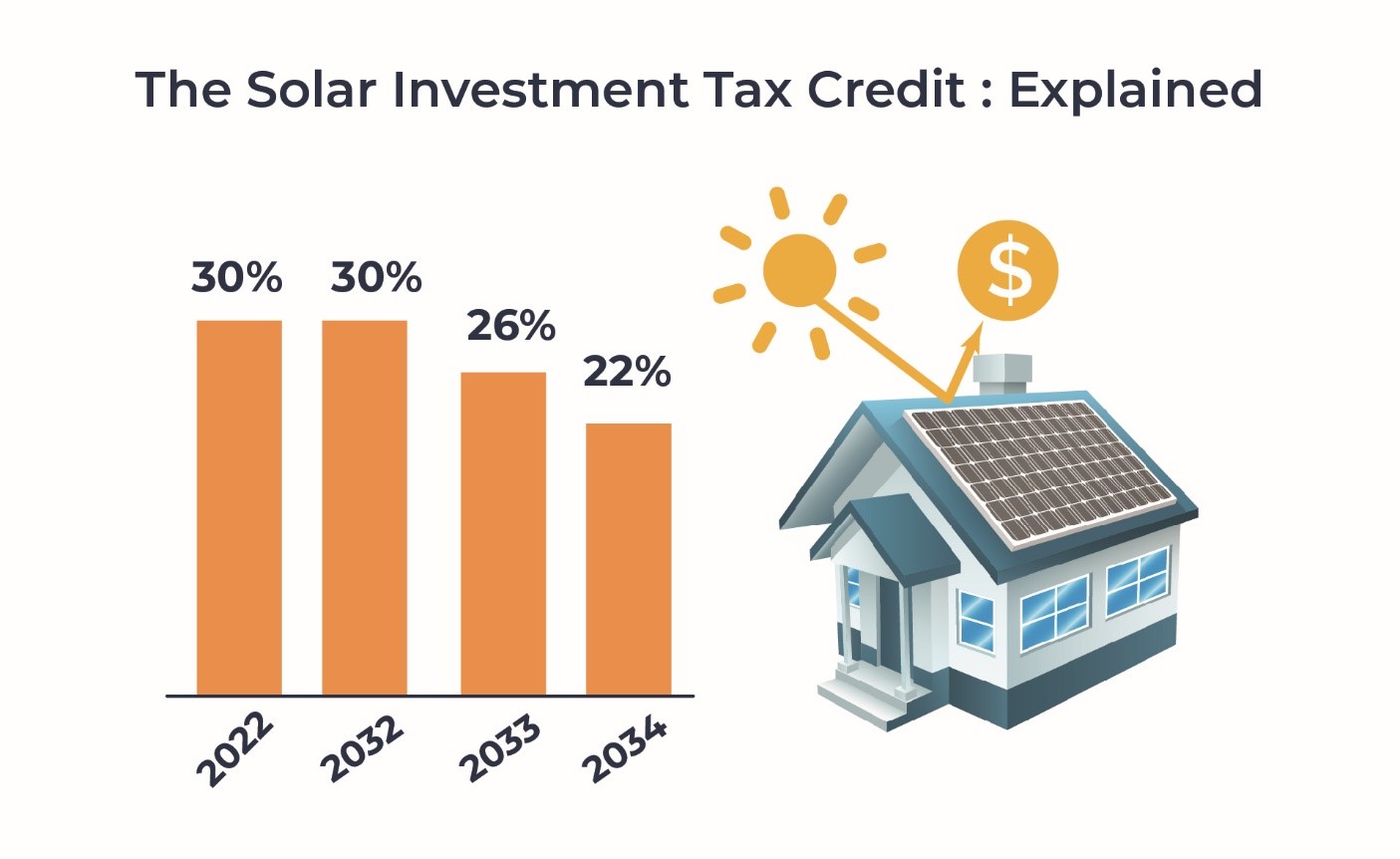
The commercial solar projects were eligible for 30% tax credit in 2022. However, this credit will be reduced to 22.5% in 2034, 15% in 2035, and in 2036, there will be no tax exemption available.
Eligibility Criteria for ITC:
Homeowners who purchase a house with solar PV modules are eligible for the ITC the year they move into the house. Those who lease a solar system or who purchase electricity through a power purchase agreement are not eligible for ITC. However, the company that leases the system or offers the PPA, collects the solar tax credit. It is smart to first consult with a tax professional to ensure that you are eligible for tax credit or not.
How to Claim Solar Tax Credit?
Homeowners who are eligible for ITC and wish to claim the credit should file for IRS form 5695 with their tax returns. Part 1 of the form calculates the credit. However, the final amount is listed on the 1040 form. Individuals who failed to claim the credit, can file for an amended return later.
Residential solar system owners can claim the federal tax credit under section 25D. Meanwhile, commercial solar panel system owners can claim it under Section 48. Homeowners need to claim the solar tax credit on their personal income taxes. However, business owners can claim this credit on their business taxes.
State Solar Tax Credits:
Some states offer their own incentives that work just like ITC. The only difference is that these credits are applicable to your state taxes rather than federal. The value of state tax credits can vary, but it doesn’t decrease the value of your federal solar tax credits. The Database of State Incentives for Renewable and Efficiency (DSIRE) will provide you with all the available information regarding solar tax credits in your state. Here are some examples of the solar tax credits that some states offer:
Arizona:
The Residential Arizona Solar Tax Credit program reimburses Arizona homeowners 25% of the cost of solar panels.
Maryland:
Taxpayers in Maryland can claim up to 30% of the cost of an energy storage system as a credit toward state income taxes.
New Mexico:
New Mexico offers taxpayers a 10% credit toward solar installation costs, which is capped to $6,000.
Massachusetts:
Homeowners in Massachusetts can receive a credit of 15% for solar installations, limited to a maximum of $1,000.
The availability and details of these state solar tax credits may vary. It is essential to consult the DSIRE database or check with your local tax authority to get the most accurate and up-to-date information on solar tax credits in your locality.
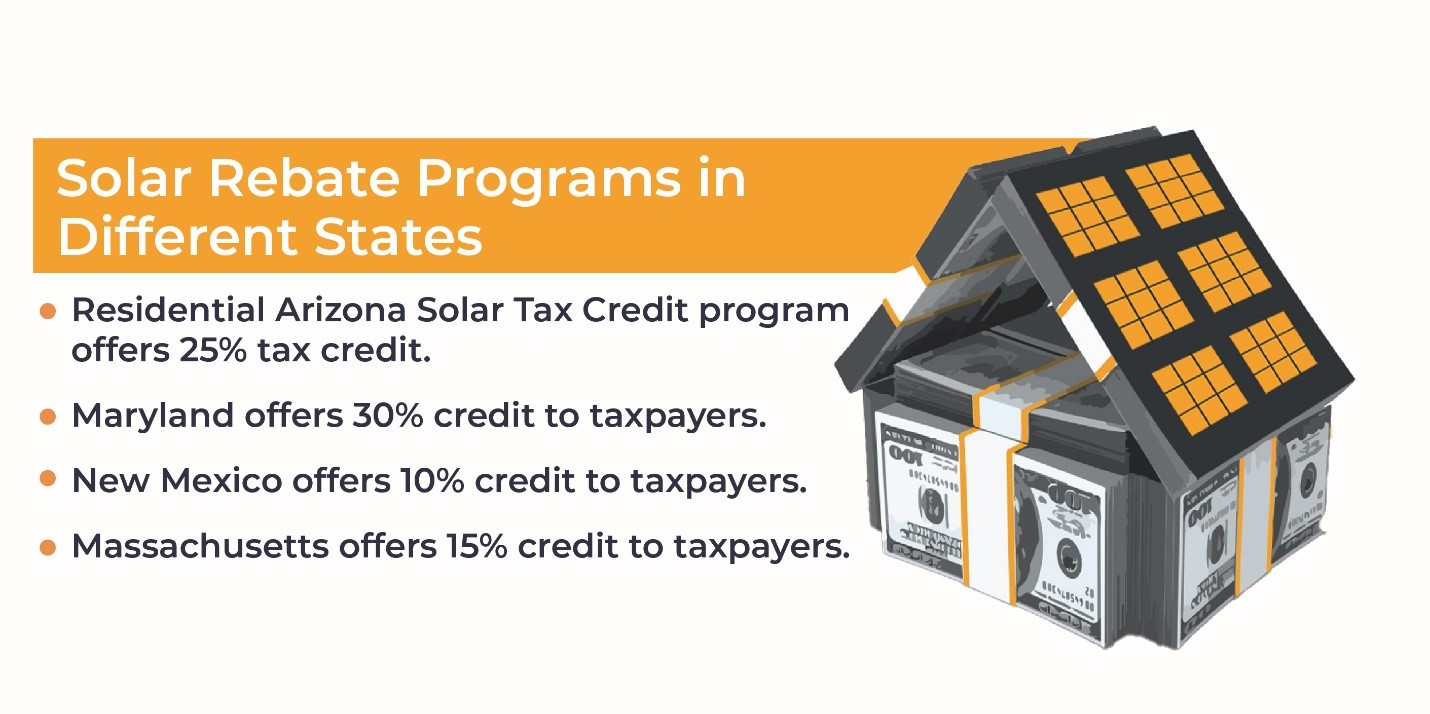
3. Solar Rebates:
Local governments, utilities, and even some solar companies offer rebates to homeowners for installing solar panels and batteries. Unlike solar tax credits, rebates are usually paid upfront to homeowners or installers, resulting in reduced installation costs.
The calculation of rebates is based on the size of your system, and eligibility for rebates is often location-specific. A reputable local installer can provide you with a better insight into available incentives. However, it is much better to use DSIRE to gather knowledge about eligibility.
Some utility companies offer incentive programs for customers using solar batteries. For example, Bring Your Own Battery programs allow utility companies to utilize customers’ batteries during specific times of the year. However, here are some popular state rebate plans:
California:
California’s Self-Generation Incentive Program (SGIP) offers dollar-per-kilowatt rebates to homeowners for the installation of solar battery solutions.
Maryland:
Maryland’s Residential Clean Energy Rebates allow residents to qualify for a $1,000 rebate on the installation of a new solar system.
Colorado:
While Colorado doesn’t have a statewide rebate program, still many utilities and local organizations offer incentives to homeowners. Energy Smart Colorado, for instance, provides rebates ranging from $400 to $2,500, depending on the residential area.
Massachusetts:
The Solar Massachusetts Renewable Target (SMART) program is available to customers of Eversource, National Grid, and Unitil. It offers bonuses to local residents based on the kilowatt-hours of electricity their solar panels produce. Moreover, the SMART program also provides additional payments for battery installations.
New Hampshire:
In New Hampshire, homeowners with solar systems of 10 kilowatts or less are eligible for local rebates. The New Hampshire Rebate allows you to claim credits of 20 cents per watt on the energy produced by your solar system. You can also claim a 30% rebate on residential solar PV modules.
Rhode Island:
Rhode Island offers homeowners the Commercial RI’s Renewable Energy Fund grant program. Under this program, homeowners can receive 85 cents per watt for the installation of a new solar system, which is usually capped at $7,000. The average home typically requires 17 to 21 solar panels to fully meet its energy demand. The average power generation capacity of solar PV modules is about 250 to 400 watts. Thus, the total savings you get from the Rhode Island rebate would be at least $4,250.
New York:
The NY-Sun Megawatt Block program provides homeowners with a dollar-per-watt rebate for their solar array installations.
Texas:
The Austin and Oncor customers can access a solar rebate program that ranges from $2,500 to $8,500 for the installation of solar panels. Similarly, Texans that get energy from AEP are eligible for a cash incentive between $2,500 to $8,500 for the kW of solar power installed in their home.
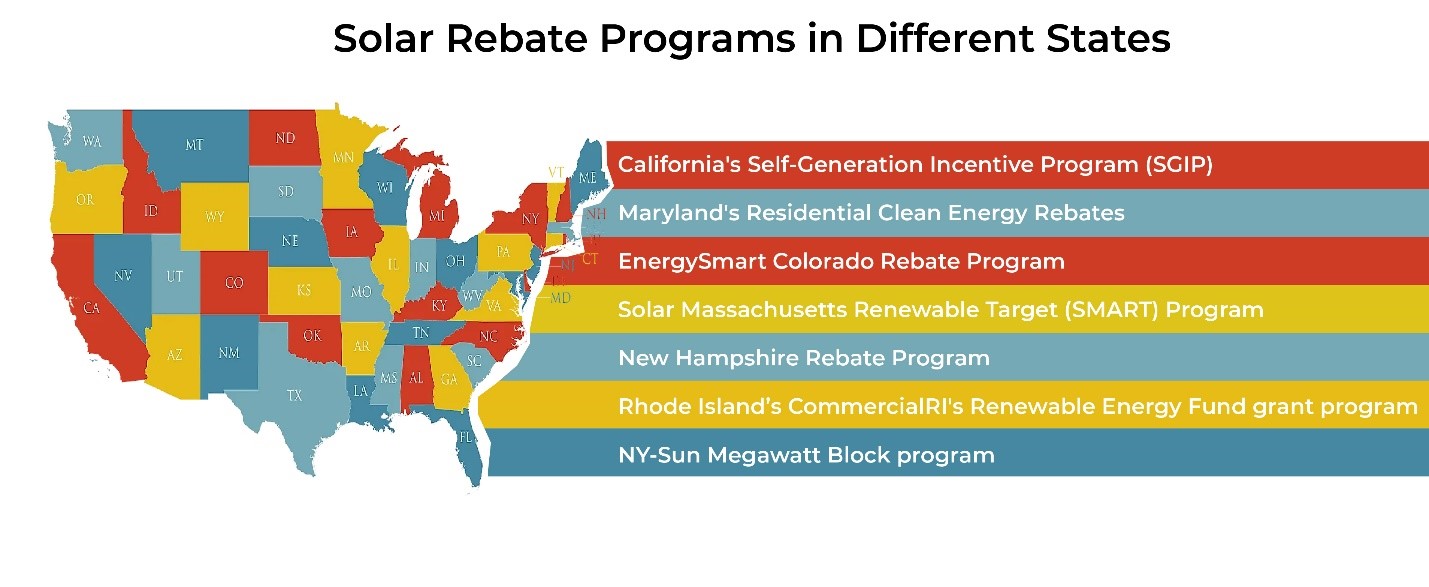
The rebate availability and details may vary from state to state. It is crucial to consult your installer to obtain the most accurate and up-to-date information on solar rebates in your area.
4. Net Metering:
Net Metering is a billing mechanism that allows homeowners and businesses with a solar system to connect to the electric grid and send back any excess electricity produced by their solar system. As a result, they receive bill credits or, in some cases, even monetary compensation if the credits aren’t fully utilized by the end of the year.
In simple terms, net metering enables you to offset your electricity consumption and earn credits for the surplus electricity generated by your solar system.
How Net Metering Works?
1. Solar System Installation:
To utilize net metering, you need to have a solar system installed. The solar panel system must be connected to the grid to ensure a continuous supply of electricity.
2. Two-way Metering
For homeowners seeking net metering, the installation of a bi-directional or net meter is necessary. This special meter can measure both the electricity consumption from the grid and the surplus energy generated from the solar PV modules.
3. Power Generation and Consumption:
When the solar system produces electricity, it first powers the household appliances. If the energy production exceeds the household’s demand, the surplus electricity is sent back to the utility grid.
4. Metering and Billing:
The net meter calculates the difference between the electricity consumed from the grid and the surplus electricity exported to the grid. Depending on the specific net metering policy of the utility company, this difference can be calculated either monthly or annually.
5. Credit or Compensation:
If the solar system generates more electricity than the homeowner consumes over a billing period, they receive credits for the excess energy. These credits are based on the retail rate of electricity, which is the same rate the customer would have paid for electricity if they had consumed it from the grid.
6. Net Billing:
At the end of the billing period, the homeowner’s electricity bill shows the net amount of electricity consumed from the grid, after accounting for the credits earned from the surplus energy. In some cases, if the credits exceed the consumption, the homeowner may receive a payment or roll over the credits to future billing periods.
It’s important to note that net metering policies have undergone changes in some states due to the introduction of new net metering policies in 2022.
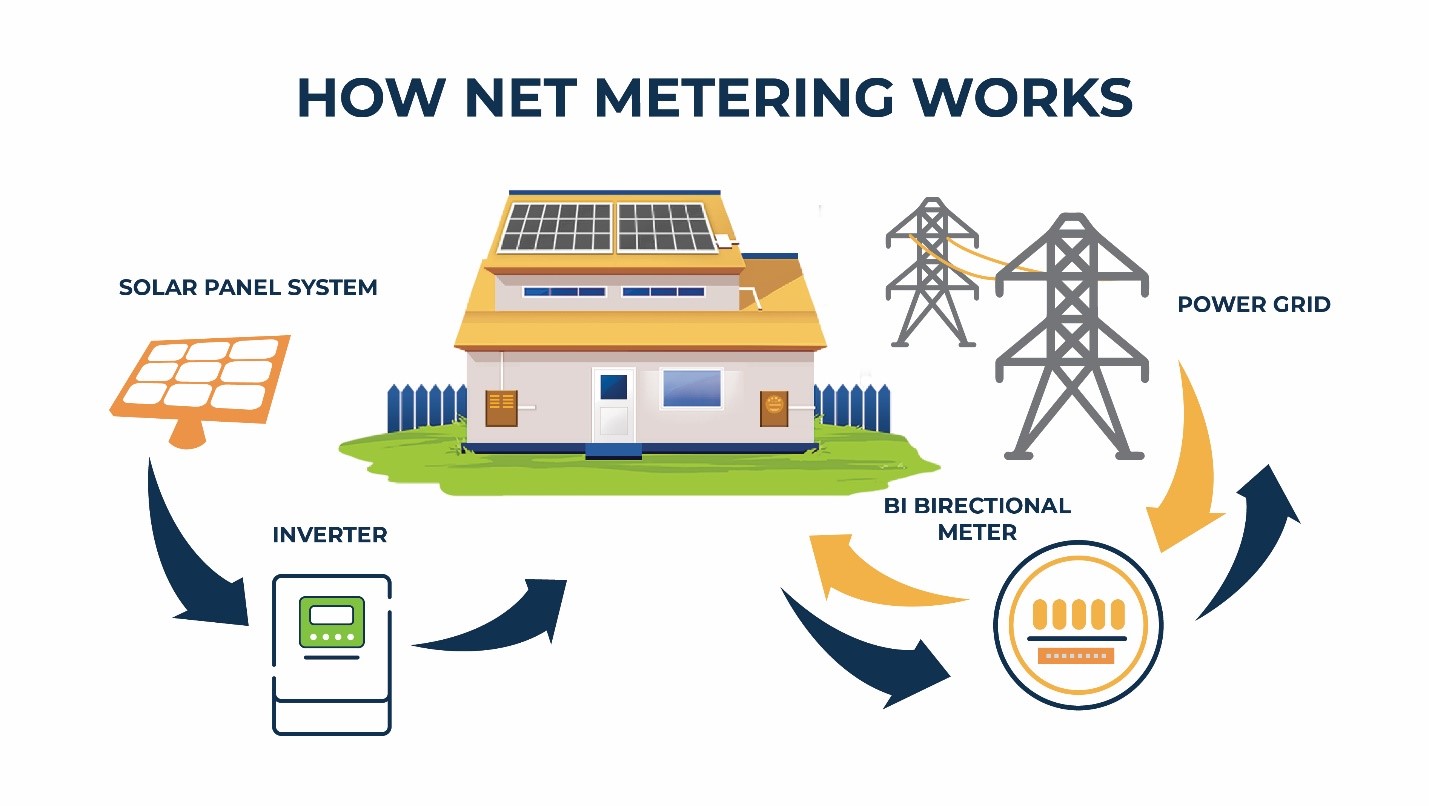
What is NEM 3.0 and How Will it Impact Solar System Owners?
The New Net Energy Metering policy, known as NEM 3.0, was implemented on December 15, 2022. NEM 3.0 introduces a significant change by reducing the compensation for excess power supplied to the electric grid.
Under the previous net metering system, many states provided a credit equivalent to the retail rate of electricity for solar energy exported to the grid. This system was known as one-to-one net metering. However, under NEM 3.0, the California Public Utilities Commission (CPUC) has established a new rate for crediting solar exports. They are now transitioning from net metering to a net billing system.
The new solar tax credits will be based on “avoided cost”. These credits are lower than the retail rate and vary based on factors such as the time of day, day of the week, and month of export. In total, there are 576 potential rates for energy exports. NEM 3.0 will reduce the value of net metering credits by 75 percent in comparison to the previous system.
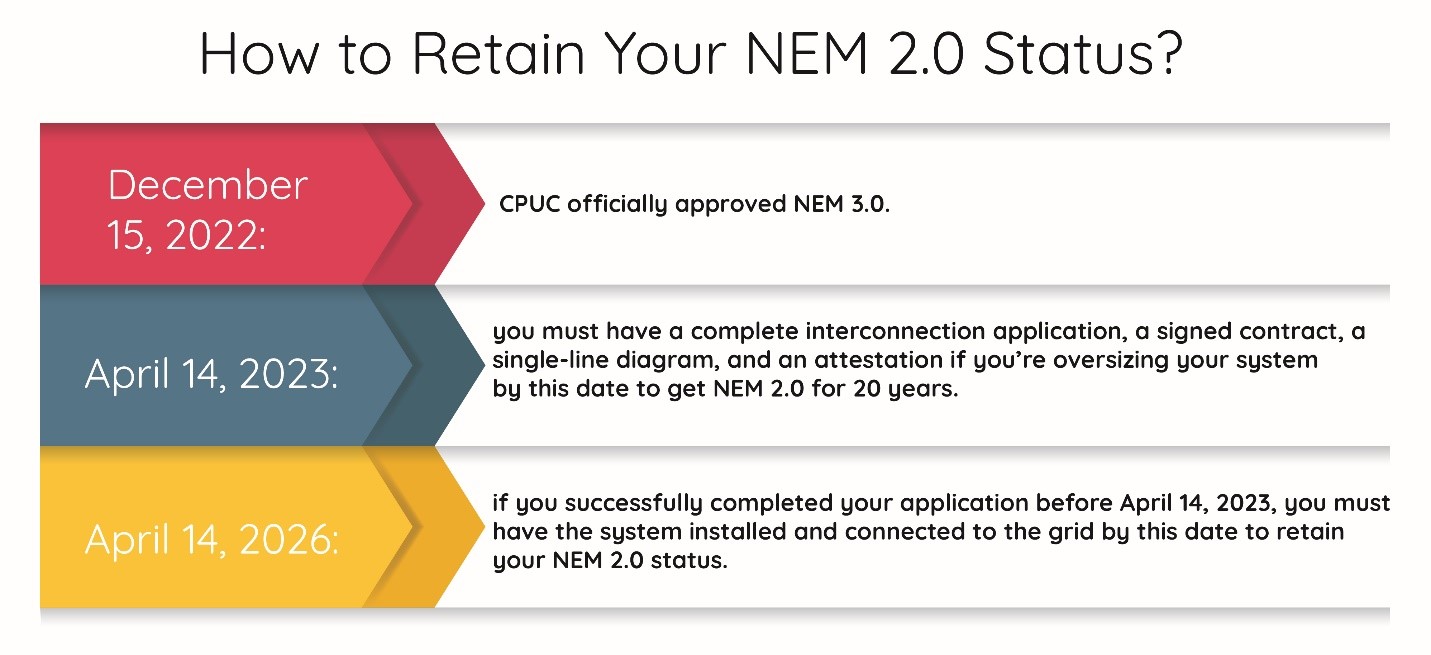
Importance of Solar Battery Systems after NEM 3.0:
In the era of NEM 3.0, installing a solar battery system will significantly increase your savings. By combining a solar panel system with a battery, you can store any excess solar energy generated on-site by your solar PV modules. This allows you to charge your battery system and utilize the stored energy at night or on cloudy days. Thus, maximizing the value of your solar system and minimizing the amount of energy you export to your utility company. This becomes particularly beneficial when time-of-use rates are higher.
The payback period for a solar system may still be longer under NEM 3.0 in comparison to NEM 2.0. However, installing battery solutions with your solar system will help you save a lot during the lifetime of your solar PV modules.
Overall, net metering provides an opportunity for homeowners and businesses to offset their electricity costs by harnessing solar energy. However, installing solar systems with battery storage will help maximize your savings and optimize your energy usage. It’s essential to stay informed about the specific net metering policies and incentives in your state or locality to make the most of these opportunities.
5. Property Tax Exemptions:
With property tax exemptions, you don’t have to pay extra taxes on the increased value of your property due to the installation of solar system. To simply put, solar property tax exemptions remove the added value of a solar system from the assessed value of your home for tax purposes. This means that even though the value of your home increases by 4% after installing a solar panel system, your property taxes will remain the same. These exemptions are meant to incentivize renewable energy by reducing the financial burden on homeowners.
For instance, the installation of rooftop solar panels can add about $15,000 to your property value. However, if the property tax rate of your state is 1.5%, the increase in home value would result in an additional $225 in property taxes each year. If your state offers property tax exemptions, then you don’t have to pay the extra $225 in your state taxes. The actual tax savings will vary depending on the specific value solar adds to your home.
Which States offer Property Tax Exemptions?
Approximately 25 states in the United States offer solar property tax exemptions. Out of these 25 states, 21 have policies that provide tax exemptions to residential solar systems, including both rooftop and ground-mounted arrays. However, the remaining four states only provide tax exemptions to non-residential solar systems. These states are Idaho, Nevada, Nebraska, and Ohio.
6. Tax Abatements for Solar Panels:
Some areas, such as New York City, offer an additional tax incentive for solar installations known as property tax abatements. A tax abatement allows homeowners to deduct some or all of the cost of installing solar from their property taxes.
In New York City’s solar tax abatement program, 5% of the solar system installation expenses are deducted from property taxes over a period of four years. It is important to note that you need to calculate abatements before other tax exemptions, such as the federal solar tax credits. This means that you can claim an abatement based on the full price of your solar system.
Moreover, several other cities, like Cleveland and Cincinnati, also offer tax abatement programs. The value and duration of these programs can vary. For example, Cleveland provides a 100% tax abatement for photovoltaic systems, which you need to pay within 10-15 years. Cincinnati offers a similar program. It’s worth noting that many abatement programs are primarily for commercial solar installations and large-scale projects.
However, the specific details and eligibility criteria for property tax exemptions and abatement programs may vary by location. It’s important to consult local regulations and authorities or seek professional advice to determine the exact incentives available in your area.
7: Sales Tax Exemption:
To reduce the upfront cost of solar installations, approximately 25 states in America offer sales tax exemptions. These exemptions may cover equipment or installation costs, and in some states, they apply to the entire solar installation process. For example, in Minnesota, you don’t have to pay any sales tax on your solar system purchase, resulting in savings of about 7% of the total installation costs.
8. Solar Renewable Energy Certificates (SRECs):
SRECs allow you to sell solar power like trading on the stock market. Under SREC programs, for every 1,000 kilowatt-hours of electricity your system produces, you earn one SREC that you can sell to utility companies. The price of SRECs varies and is driven by demand, reaching as high as $300 per SREC in some regions.
The average residential solar installation is around 6 kilowatts, with an energy production capacity ranging from approximately 720 to 900 kilowatt-hours per month. Thus, by effectively utilizing solar panels, you can earn about 8 to 10 SRECs per year, amounting to at least $2,400. States that offer SRECs include New Jersey, Illinois, Pennsylvania, Maryland, Ohio, and Virginia.
9. Low-interest loans:
Some states provide low-interest loans to homeowners, in addition to cash incentives, for going solar. These loans can be used for various solar systems, including rooftop solar panels and batteries. The state of Michigan offers these loan programs.
In conclusion, federal and state incentives aim to lower the upfront cost of solar systems. The extension of the federal investment tax credit will significantly contribute to America’s goal of achieving net-zero carbon emissions by 2032. To fully benefit from these incentives, it is important to own the solar system rather than leasing it. Additionally, working with a reputable installer ensures that you don’t miss out on any available financial incentives and rebates. A professional installation company will include any applicable incentives and rebates in your initial quote.





